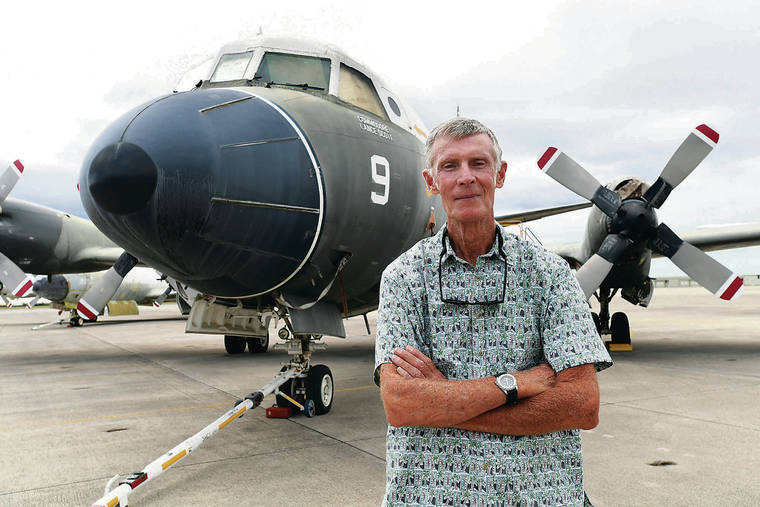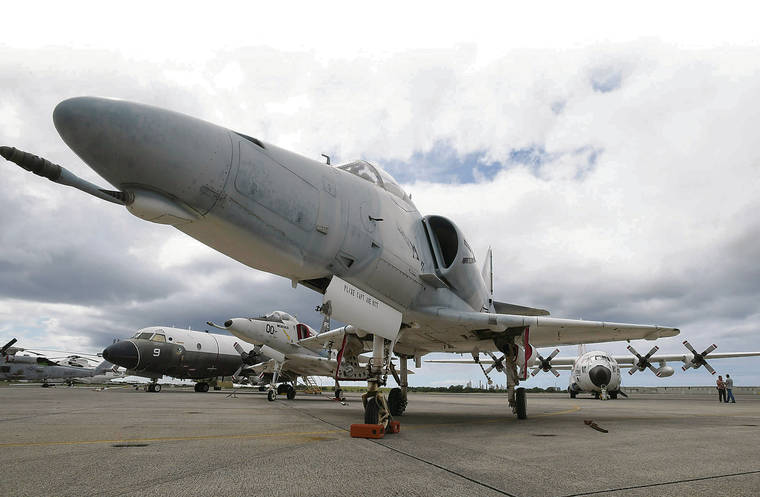A nonprofit air museum that opened 20 years ago and was built on Naval Air Station Barbers Point’s 57-year history is being evicted from state airport land over long-standing contract issues that led to a running dispute with the state Department of Transportation Airports Division.
Naval Air Museum Barbers Point was closed as of Thursday, Director Brad Hayes said. The museum said it wants to stay at the current location but has been frustrated for years in seeking contract renewal with what it views as a dysfunctional government agency.
Among its collection is a Coast Guard C-130H Hercules, two Navy P-3 Orion sub hunters, a DC-8, three A-4 Skyhawks, an F-4 Phantom, multiple Navy and Marine Corps helicopters, and military vehicles.
When the base was shuttered in 1999 — closing out its history as the largest naval air station in the Pacific — the museum started exhibiting some of the aircraft, including a P-3 Orion. During the Cold War the base had 80 to 100 of the propeller-driven planes.
The state on Oct. 30 sent a letter to Hayes saying the grassroots museum had been given 30 days to comply with insurance requirements, unauthorized storage of exhibit items and environmental violations.
“To date, you have only addressed the environmental violations and taken no action to comply with insurance and authorized storage of property on Kalaeloa Airfield,” the letter said.
Roy Sakata, manager of Oahu airports, said in the letter that notices were sent to the military owners of some of the aircraft — in this case the Navy and Marine Corps — “advising them of the situation and requesting immediate reclamation and removal.”
Hayes said the environmental violations and
insurance issue are a smokescreen for a personality clash that led to the eviction letter.
“The (environmental)
violations were drips and stains under the vehicles. We mitigated all of that.
The report was closed out,” Hayes said Thursday.
Hayes also said “there is
no doubt of us never having insurance.”
The retired Marine opened the museum in 1999 when the Navy base closed.
“We inherited all the aircraft the Navy was going to scrap,” he said. At the time he had three A-4 Skyhawks, an F-4 Phantom and a P-3 Orion, he said.
“The aircraft are touchstones to that past,” Hayes added. “When people come out, veterans get closure from” seeing the planes up close.
Museum historian and Vice President Brad Sekigawa told the story of a man in his late 40s or early 50s coming out in about 2015 to specifically get up close with an A-4 Skyhawk.
The man was able to sit in the cockpit and started crying uncontrollably and explained that it was the type of aircraft his father had died in during the Vietnam War, he said.
The museum operated on an appointment-only basis and would get a couple hundred people every two weeks, plus school tours, Hayes said. “So I would say (visitation) is in the thousands a year,” he said.
The military “does all kinds of training out here,” Hayes added, with medical personnel practicing emergency evacuation training on the C-130, a type of aircraft still used by the military.
The Coast Guard has borrowed back the aircraft — which was retired from the adjacent Coast Guard air station — for training during a search and rescue conference. Some TV shows also have filmed at the museum.
The state Department of Transportation said the museum had a 30-day revocable permit for use of 1,522 square feet of land. However, the nonprofit expanded well beyond that on the airport tarmac.
The state noted a “considerable unauthorized area being occupied by unpermitted exhibition pieces.”
The Airports Division “has repeatedly requested the necessary documentation regarding insurance and fluid spill violations, however the (museum) did not furnish the documentation until after the letter of revocation was received,” the agency said in a statement.
The museum “has been provided multiple opportunities to correct the unauthorized use of land outside its permitted area and it has failed to comply. The notice to vacate stands.”
Hayes said contract issues extend back to around 2012, when a deal for aircraft parking was canceled by the state when it needed to trench across the aircraft exhibit area.
From there, lease renewal entered “limbo land,” Hayes said. The state wanted to move the museum, but the chosen spot turned out to be where a Hawaii National Guard hangar was built.
“Now they are like, ‘Well, these aircraft don’t have a lease, and they are parked and they’ve got more stuff parked than they are paying for,’” Hayes said. “But that all predicates on them killing the lease off years ago that we had.”
The museum pays the state about $1,000 in rent a month. The Airports Division has no other use for the paved tarmac, he said.
“They told the lieutenant governor they don’t (have another use for the expanse), because he asked,” Hayes said.
More recently, Hayes said, the museum has focused on paying close to $10,000 in back taxes to the city.
“Now it’s a matter of a space permit and negotiations for size and space,” according to Hayes. “So the last that I had heard from the Airports Division, in January of 2019, was that we would be given an area the size of one of the hangars to park our stuff on.”
Hayes said the state likely would be taking on the disposal of large aged aircraft such as the DC-8 if the eviction stands.
“So the airplanes will be sitting in the weeds when we could have had a world-class flying museum, if they just worked with us,” Hayes said.
Navy veteran Doug Gillet, 72, who flew with P-3 squadrons out of Barbers Point from 1967 to 1998 and who occasionally gives tours at the museum, said the museum planes are a dwindling reminder of passing times.
“When the only (P-3) squadron left on the island leaves over at Kaneohe Bay and goes to Jacksonville (Fla.) next year,” Gillet said, “these (museum P-3s) will be the only two birds left on the island.”








